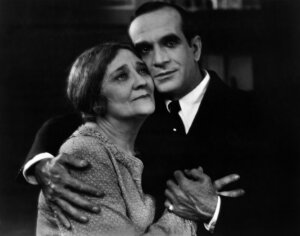How Al Jolson helped to remake America
A new biography from Richard Bernstein explores the meteoric success of the Jewish performer, while confronting the reviled practice of blackface that made Jolson a star

Al Jolson Photo by Getty Images
Only in America: Al Jolson and The Jazz Singer
By Richard Bernstein
Knopf, 272 pages, $28
Richard Bernstein wastes no time dealing with the radioactive subject of blackface in his fascinating new biography of the Jewish singer and actor Al Jolson. He puts the rightly reviled practice in historical context, then goes on to explain how Jolson’s public adoration and widespread acceptance in the early 20th century marked the beginning of the “Judaizing” of American culture, a moment of cultural transformation when the American public was newly willing to accept people of different ethnic and racial backgrounds.
Jolson, born Asa Yoelson in a shtetl in Lithuania, then part of the Russian empire, immigrated to the U.S. in 1894, when he was nine. Within roughly 15 years, he was the most famous and highly paid popular entertainer in America, the equivalent of baseball’s Babe Ruth, Charle Chaplin in silent movies, and Enrico Caruso in opera. But unlike them, his legacy has faded since his death in 1950, his reputation tarnished by his starring role in the once-acclaimed, now controversial 1927 movie The Jazz Singer and his long history of performing in blackface.
There have been other biographies of Jolson, including Herbert G. Goldman’s 1988 Jolson: The Legend Comes to Life, which Bernstein cites, and other books that look at the foundational role of Jolson’s generation of immigrant Jews in the development of American pop culture, notably Neal Gabler’s An Empire of Their Own: How the Jews Invented Hollywood.
Bernstein tells his version in remarkably concise fashion, interspersing the basic facts of Jolson’s life with rich layers of cultural history. Briefly, Jolson dropped out of school at age 12 to make his way in the rough-and-tumble world of show business, defying his religiously observant father, who expected him to follow in his footsteps and become a cantor.
Today, Jolson’s cohort is the stuff of legend — George Jessel, George Burns, Groucho Marx, Eddie Cantor, Jack Benny, Danny Kaye, all descendants of Russian and Eastern European Jews who hustled their way to the top of the entertainment industry from the lowly ranks of vaudeville, burlesque, and busking.
Early in his career, Jolson and his brother Harry worked up comedy routines that featured the stereotypical caricature of a Jew with hooked nose, unkempt hair, and dark shabby clothes. When the skits weren’t getting the laughs Jolson wanted, he took the suggestion of his elderly Black valet, applied burnt cork to his face, and got the “riotous enthusiasm” he was after. Or so he told a newspaper at the time. His brother offered up a different story, saying the suggestion to “black up” came from an Irish comedian who played in blackface.
In any case, Bernstein makes no excuses for it, noting that it was based on a “sentimentalized portrayal of blackness that … masked the racist history of the country” and worked for Jolson and other white performers “because they didn’t have the burden of Black skin.” He also points out how common it was in show business at the time, even among Black minstrel entertainers.

By the time Jolson was headlining shows on Broadway, blackface was an integral part of his act including a Black character named Gus, who was “disadvantaged but smarter than the supposedly superior characters around him.” Bernstein duly notes the oddity of a son of an Orthodox Jewish woman who spent all but one year of her life in a Lithuanian shtetl waxing nostalgic in his songs about “my mammy from Alabammy.”
But in doing so, Bernstein argues, Jolson and other immigrant Jews in musical theater entertainment at the time “helped make America more vulgar, morally looser, but also more open-minded.”
“They fostered the crossbred, mixed-up hybrid culture that became deeply. uniquely American even as it captured the world,” Bernstein writes.
Even in a career defined by outsize success and achievement, the story of The Jazz Singer stands alone. The movie, Hollywood’s first talkie, was based on a short story, “Day of Atonement,” by an up-and-coming young Jewish writer named Samson Raphaelson, who generally kept Yiddishkeit out of his stories with the notable exception of this one, inspired by Jolson’s life.
The main character, Jakie Rabinowitz, has an old-fashioned Orthodox father like Jolson’s, who trains him to be a cantor. But Jakie rebels, runs away, changes his name to Jack Robin, and falls in love with a gentile chorus girl, eventually finding success in vaudeville.
On the night he’s supposed to open on Broadway — by coincidence, the eve of Yom Kippur, a scheduling glitch that Bernstein notes would never happen in New York because of its heavily Jewish population — Jack’s father dies and his mother begs him to take his place in the synagogue. He accedes to her wishes, assuming it will kill his career. But unbeknownst to him, his producer has come to the shul, where he is enthralled by Jack’s rendering of the “ravishing, tragedy-tinged minor-key beauty of Kol Nidre” and decides to keep him in the show.
The movie was a national sensation, “made by the Jews who created Hollywood but who rarely made movies about Jews,” Bernstein says. Though it featured authentic-looking synagogue scenes and the chanting of Hebrew prayers, it struck a chord with Americans of all races and creeds.
Bernstein sees the success of the movie as a major step in the “Judaization” of American culture, paving the way for the likes of Milton Berle, Jack Benny and Sid Caesar, Fiddler on the Roof and Funny Girl, the plays of Neil Simon, Gilda Radner on Saturday Night Live, television shows like Seinfeld, and movies like Woody Allen’s.
For all of that, Bernstein says, we have Jolson to thank — because in remaking himself, he helped remake America.






















